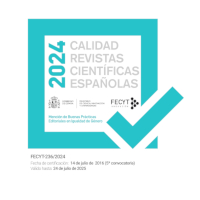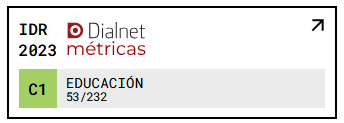The probability in the problems of high school Math Olympics in Spain
DOI:
https://doi.org/10.18172/con.4970Keywords:
Mathematical Olympiad, mathematical tasks, cognitive demand, onto-semiotic approach, probability learningAbstract
Among the participants in Mathematical Olympiads, it is usual to find mathematically gifted students. Therefore, from the point of view of the research about gifted students, it is interesting to analyze the problems proposed in these events. The objective of this work is to analyze the cognitive demand, the languages and the procedures of the mathematical tasks proposed in the problems on probability in the individual tests of both the semifinal and the final in the Aragonese Mathematical Olympiad (1989-2019) and the problems carried out in the individual test of the National Mathematical Olympiad (1990-2019). We focus our attention on probability problems to characterize the representativeness of this content in the Olympics. The results show that all the proposed tasks in the Olympics are of a high level according to the cognitive demand model, which is suitable as a proposal for the high mathematical ability students, including tasks of the higher level according to the same model, whose satisfactory resolution could become an indicator of high mathematical ability. On the other hand, the scarcity of probability problems in these tests, shows the need to propose more in these contests, promoting their learning in secondary education.
Downloads
References
Baltaci, S. (2016). Examination of Gifted Students' Probability Problem Solving Process in Terms of Mathematical Thinking. Malaysian Online Journal of Educational Technology, 4(4), 18-35.
Batanero, C. (2005). Significados de la probabilidad en la educación secundaria. Revista Latinoamericana de Investigación en Matemática Educativa, RELIME, 8(3), 247-263.
Batanero, C. (2006). Razonamiento probabilístico en la vida cotidiana: un desafío educativo. Jornadas de Investigación en el Aula de Matemáticas. Estadística y azar. Granada: Thales.
Batanero, C. (2014). Probability teaching and learning. En S. Lerman (Ed.) Encyclopedia of Mathematics Education. Dordrecht: Springer.
Batanero, C., Henry, M. y Parzysz, B. (2005). The nature of chance and probability. En G. A. Jones (Ed.), Exploring probability in school: Challenges for teaching and learning (pp. 15-37). New York: Springer.
Benedicto, C., Jaime, A. y Gutiérrez, Á. (2015). Análisis de la demanda cognitiva de problemas de patrones geométricos. En C. Fernández, M. Molina y N. Planas (Eds.), Investigación en Educación Matemática XIX (pp. 153-162). Alicante: SEIEM.
Borovcnik, M. y Kapadia, R. (2009). Research and developments in probability education. International Electronic Journal of Mathematics Education, 4(3), 111-130.
Cobo, B. (2003). Significado de las medidas de posición central para los estudiantes de secundaria. Tesis Doctoral. Universidad de Granada.
Díaz, C. y de la Fuente, I. (2005). Razonamiento sobre probabilidad condicional e implicaciones para la enseñanza de la estadística. Epsilon, 59, 245-260.
Engel, J. (2019). Cultura estadística y sociedad: ¿Qué es la estadística cívica? En J. M. Contreras, M. M. Gea, M. M. López-Martín y E. Molina (Eds.), Actas del Tercer Congreso Internacional Virtual de Educación Estadística. Granada.
Estrada, A., Batanero, C. y Fortuny, J. M. (2004). Un estudio sobre conocimientos de estadística elemental de profesores en formación. Educación matemática, 16(1), 89-111.
Gairín, J. M. y Escolano, R. (2009). Proporcionalidad aritmética: buscando alternativas a la enseñanza tradicional. Suma, 62, 35-48.
Gairín, J. M., Muñoz-Escolano, J. M. y Oller-Marcén, A. M. (2013). Anomalías en los procesos de identificación de errores en las pruebas escritas de matemáticas de las P.A.U. Campo abierto: Revista de educación, 32(2), 27-51.
Gal, I. (2005). Towards “probability literacy” for all citizens: Building blocks and instructional dilemmas. En G. Jones (Ed.), Exploring probability in school: Challenges for teaching and learning, (pp. 39-63). New York: Springer.
Gigerenzer, G. (1994). Why the distinction between single-event probabilities and frequencies is important for psychology (and vice versa). In Subjective probability (pp. 129-161). Wiley.
Gigerencer, G. (2002). Calculated risks: How to know when numbers deceive you. New York: Simon & Schuster.
Godino, J. D. (2002). Un enfoque ontológico y semiótico de la cognición matemática. Recherches en Didactiques des Mathematiques, 22(2/3), 237‐284.
Godino, J. D. y Batanero, C. (1998). Clarifying the meaning of mathematical objects as a priority area of research in mathematics education. En A. Sierpinska y J. Kilpatrick (Eds.), Mathematics Education as a Research Domain: A Search for Identity (pp. 177-195). Dordrecht: Kluwer.
Godino, J. D., Batanero, C. y Font, V. (2007). The onto-semiotic approach to research in mathematics education. ZDM, 39(1-2), 127-135.
Godino, J. D., Batanero, C. y Font, V. (2019). The onto-semiotic approach: implications for the prescriptive character of didactics. For the Learning of Mathematics, 39(1), 37-42.
Gómez, E. (2014). Evaluación y desarrollo del conocimiento matemático para la enseñanza de la probabilidad en futuros profesores de educación primaria. Tesis doctoral. Universidad de Granada.
Guinjoan, M., Gutiérrez, Á. y Fortuny, J.M. (2015). Análisis del comportamiento de alumnos expertos resolutores de problemas en el contexto del concurso matemático Pruebas Cangur. Enseñanza de las Ciencias, 33(1), 29-46.
Huitrado, J.L. y Climent, N. (2014). Conocimiento del profesor en la interpretación de errores de los alumnos en álgebra. PNA, 8(2), 75-86.
Jaime, A. y Gutiérrez, A. (2014). La resolución de problemas para la enseñanza a alumnos de Educación Primaria con altas capacidades matemáticas. En B. Gómez, L. Puig (Eds.), Resolver problemas. Estudios en memoria de Fernando Cerdán (pp. 147-190). Valencia: PUV.
Jaime, A. y Gutiérrez, Á. (2017). Investigación sobre estudiantes con alta capacidad matemática. En J.M. Muñoz-Escolano, A. Arnal-Bailera, P. Beltrán-Pellicer, M.L. Callejo y J. Carrillo (Eds.), Investigación en Educación Matemática XXI (pp.71-89). Zaragoza: SEIEM.
Jones, G. A. (Ed.) (2005). Exploring probability in school: Challenges for teaching and learning. New York: Springer.
Jones, D. L. y Tarr, J. E. (2007). An examination of the levels of cognitive demand required by probability tasks in middle grades mathematics textbooks. Statistics Education Research Journal, 6(2), 4-27.
Krippendorff, K. (2013). Metodología de análisis de contenido. Teoría y práctica. Barcelona: Paidós.
NCTM. (2014). Principles to action: Ensuring mathematical success for all. National Council of Teachers of Mathematics: United State of America.
Olszewski-Kubilius, P. y Lee, S. (2004). The role of participation in in-school and outside-of-school activities in the talent development of gifted students. Journal of Secondary Gifted Education, 15(3), 107-123.
Ortega, T., Berciano, A. y Pecharromán, C. (2018). Complementos de formación matemática. Madrid: Síntesis.
Ortiz, J.J., Albanese, V. y Serrano, L. (2016). El lenguaje de la estadística y probabilidad en libros de texto de Educación Secundaria Obligatoria. En J. A. Macías, A. Jiménez, J. L. González, M. T. Sánchez, P. Hernández, C. Fernández, F. J. Ruiz, T. Fernández y A. Berciano (Eds.), Investigación en Educación Matemática XX (pp. 397-406). Málaga: SEIEM
Roldán, A., Batanero, C. y Beltrán-Pellicer, P. (2018). El diagrama de árbol: un recurso intuitivo en Probabilidad y Combinatoria. Epsilon, 100, 49-63.
Rotger, L., y Ribera, J. M. (2019). Designing a Video Course. The Case of the Online Course of Mathematical Olympiads. En International Workshop on Learning Technology for Education in Cloud (pp. 79-89). Springer, Cham.
Smith M. S. y Stein, M. K. (1998). Selecting and creating mathematical tasks: From Research to Practice. Mathematics Teaching in the Middle School, 3, 344-350.
Shuard, H. y Rothery, A. (Eds.) (1984). Children reading mathematics. London: Murray.
Stein, M. K., Grover, B. W. y Henningsen, M. (1996). Building student capacity for mathematical thinking and reasoning: An analysis of mathematical tasks used in reform classrooms. American educational research journal, 33(2), 455-488.
Subotnik, R. F., Miserandino, A. D. y Olszewski-Kubilius, P. (1996). Implications of the Olympiad studies for the development of mathematical talent in schools. International Journal of Educational Research, 25, 563–573.
Toh, T. L. (2013). Mathematics Competition Questions and Mathematical Tasks for Instructional Use. En B. Kaur (Eds.) Nurturing Reflective Learners in Mathematics: Yearbook 2013 (pp. 189-207). Singapore: World Scientific, AME.
Downloads
Published
How to Cite
Issue
Section
License
The authors retain copyright of articles and authorize Contextos Educativos. Revista de Educación the first publication. They are free to share and redistribute the article without obtaining permission from the publisher as long as they give appropriate credit to the editor and the journal.
Self-archiving is allowed too. In fact, it is recommendable to deposit a PDF version of the paper in academic and/or institutional repositories.












